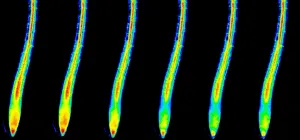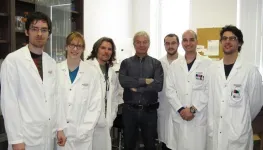INFORMATION:
About the IASLC:
The International Association for the Study of Lung Cancer (IASLC) is the only global organization dedicated solely to the study of lung cancer and other thoracic malignancies. Founded in 1974, the association's membership includes nearly 7,500 lung cancer specialists across all disciplines in over 100 countries, forming a global network working together to conquer lung and thoracic cancers worldwide. The association also publishes the Journal of Thoracic Oncology, the primary educational and informational publication for topics relevant to the prevention, detection, diagnosis, and treatment of all thoracic malignancies. Visit http://www.iaslc.org for more information.
About the JTO Clinical and Research Report:
JTO Clinical and Research Reports is the official open access journal of the International Association for the Study of Lung Cancer. This monthly publication broadens the reach of the IASLC throughout the world, offering unfettered access to the thoracic oncology community.
Journal of Thoracic Oncology (JTO), the official journal of the International Association for the Study of Lung Cancer, is the primary educational and informational publication for topics relevant to the prevention, detection, diagnosis, and treatment of all thoracic malignancies. JTO emphasizes a multidisciplinary approach and includes original research reviews and opinion pieces. The audience includes epidemiologists, medical oncologists, radiation oncologists, thoracic surgeons, pulmonologists, radiologists, pathologists, nuclear medicine physicians, and research scientists with a special interest in thoracic oncology.
Lymph node collection kit may improve long-term survival after lung cancer surgery
2021-03-23
(Press-News.org) Denver--March 26, 2021---A lymph node collection kit can help surgeons attain compete resection and improve long-term survival after curative-intent lung cancer surgery, according to a study published in the Journal of Thoracic Oncology Clinical and Research Reports. The journal is published by the International Association for the Study of Lung Cancer.
Surgical resection is the most important curative treatment for non-small cell lung cancer (NSCLC). With successful implementation of lung cancer screening programs, the proportion of patients with NSCLC who undergo surgery is likely to increase significantly.
"However, poor surgical quality reduces the survival benefit of curative-intent surgery and suboptimal pathologic nodal evaluation is the most prevalent NSCLC surgery quality deficit. The problem is global, and prevalent across institutions of different characteristics," said co-author Matthew Smeltzer, PhD, University of Memphis School of Public Health, Memphis, Tenn.
The IASLC has proposed a revision of the residual disease (R-factor) classification, from complete (R0), microscopic incomplete (R1) and grossly incomplete (R2) to R0, 'R-uncertain', R1 and R2. The adverse prognostic impact of R-uncertainty has been independently validated, with the majority caused by poor nodal evaluation.
"We previously demonstrated longer survival after surgical resection with a lymph node specimen collection kit, published in the Journal of Thoracic Oncology in February, and now evaluate R-factor redistribution as the mechanism of its survival benefit," Dr. Smeltzer said.
The kit includes 12 anatomically pre-labelled specimen containers and a checklist to indicate certain lymph node stations mandated for examination.
"We designed it to improve the intraoperative retrieval of lymph nodes compatible with evidence-based guidelines, the secure transfer of lymph node specimens between surgery and pathology teams, and the accurate identification of the anatomic provenance of lymph node specimens to encourage thorough and accurate pathologic evaluation," he said.
An ongoing NIH-funded population-based Dissemination and Implementation project (2 R01 CA172253), the Mid-South Quality of Surgical Resection (MSQSR) project involves 15 hospitals in Eastern Arkansas, North and Central Mississippi and Western Tennessee. The principal investigator, Ray Osarogiagbon, MD, of Baptist Memorial Health Care Corporation in Memphis, Tenn., is a member of the IASLC's Staging and Prognostic Factors Committee. In this particular analysis, Dr. Smeltzer and his co-researchers analyzed 3,505 lung resections between 2009-2019 from the MSQSR cohort.
Of 3,505 resections, 34% were R0, 60% R-uncertain, and 6% R1/2. The R0 percentage increased from 9% in 2009 to 56% in 2019. Kit cases were 66% R0 and 29% R-uncertain, compared to 14% R0 and 79% R-uncertain in non-kit cases (p < 0.0001). "Compared to non-kit resections, kit resections had 12.6 times the adjusted odds of R0 vs. R0 uncertain," Dr. Smeltzer reported.
Kit cases also had lower percentages of non-examination of lymph nodes (ie. pNX), 1% vs. 14% (p < 0.0001) and non-examination of mediastinal lymph nodes, 8% vs. 35% (p < 0.0001). With the kit, more R-uncertain cases had examination of stations 7 (43% vs. 22%, p < 0.0001) and 10 (67% vs. 45%, p < 0.0001).
The adjusted hazard ratio (aHR) for kit cases versus non-kit cases was 0.75 ([CI 0.66-0.85], p < 0.0001); aHR for R0 versus R-uncertain was 0.78 ([CI: 0.69-0.88], p < 0.0001). In 2,100 subjects with R-uncertain resections, kit cases had an aHR of 0.79 versus non-kit cases ([CI: 0.64-80.99], p = 0.0384); however, in the 1,199 R0 resections the survival difference was not significant (aHR: 0.85[0.68-1.07], p = 0.17).
Dr. Smeltzer pointed out that a more carefully controlled trial is planned to corroborate these results.
"Ultimately, the main limitation of this study is that it was not a randomized controlled trial. We propose to conduct such a trial to further evaluate the lymph node kit," he said.
ELSE PRESS RELEASES FROM THIS DATE:
Moiré effect: How to twist material properties
2021-03-23
The discovery of the material graphene, which consists of only one layer of carbon atoms, was the starting signal for a global race: Today, so-called "2D materials" are produced, made of different types of atoms. Atomically thin layers that often have very special material properties not found in conventional, thicker materials.
Now another chapter is being added to this field of research: If two such 2D layers are stacked at the right angle, even more new possibilities arise. The way in which the atoms of the two layers interact creates intricate geometric patterns, and these patterns have a decisive impact on the material properties, as a research team from TU Wien and the University of Texas ...
Cephalopods: Older than was thought?
2021-03-23
The possibly oldest cephalopods in the earth's history stem from the Avalon Peninsula in Newfoundland (Canada). They were discovered by earth scientists from Heidelberg University. The 522 million-year-old fossils could turn out to be the first known form of these highly evolved invertebrate organisms, whose living descendants today include species such as the cuttlefish, octopus and nautilus. In that case, the find would indicate that the cephalopods evolved about 30 million years earlier than has been assumed.
"If they should actually be cephalopods, we would have to backdate the origin of cephalopods into the early Cambrian period," says Dr Anne Hildenbrand ...
Artificial neurons help decode cortical signals
2021-03-23
Russian scientists have proposed a new algorithm for automatic decoding and interpreting the decoder weights, which can be used both in brain-computer interfaces and in fundamental research. The results of the study were published in the Journal of Neural Engineering.
Brain-computer interfaces are needed to create robotic prostheses and neuroimplants, rehabilitation simulators, and devices that can be controlled by the power of thought. These devices help people who have suffered a stroke or physical injury to move (in the case of a robotic chair or prostheses), communicate, use a computer, and operate household appliances. In addition, in combination with machine learning methods, neural interfaces ...
'Zombie' genes? Research shows some genes come to life in the brain after death
2021-03-23
In the hours after we die, certain cells in the human brain are still active. Some cells even increase their activity and grow to gargantuan proportions, according to new research from the University of Illinois Chicago.
In a newly published study in the journal Scientific Reports, the UIC researchers analyzed gene expression in fresh brain tissue -- which was collected during routine brain surgery -- at multiple times after removal to simulate the post-mortem interval and death. They found that gene expression in some cells actually increased after death.
These 'zombie genes' -- those that increased expression after the post-mortem interval -- were specific to one type of cell: inflammatory cells called ...
Researchers show where and how plants detect the nutrient potassium
2021-03-23
Potassium is an essential nutrient for all living things. Plants need it in large quantities, especially for growth and in order to withstand stress better. For this reason, they absorb large quantities of potassium from the soil. In agriculture, this leads to a lack of available potassium in the soil - which is why the mineral is an important component in fertilizers. A team of German and Chinese researchers has now shown, for the first time, where and how plants detect potassium deficiency in their roots, and which signalling pathways coordinate the adaptation of root growth and potassium absorption ...
Containing the coronavirus effects on the nervous system
2021-03-23
A number of studies have shown that human coronaviruses, including SARS-CoV-2 which causes COVID-19, appear to attack neurons and the nervous system in vulnerable populations. This neuroinvasion through the nasal cavity leads to the risk of neurological disorders in affected individuals. Research conducted at the Institut national de la recherche scientifique (INRS) has identified ways to prevent the spread of infection within the central nervous system (CNS). The study, led by Professor Pierre Talbot and his research associate Marc Desforges, now at CHU-Sainte-Justine, ...
Physical activity helps curb low-grade inflammation in children
2021-03-23
According to a recent Finnish study, accumulating more brisk and vigorous physical activity can curb adiposity-induced low-grade inflammation. The study also reported that diet quality had no independent association with low-grade inflammation. The findings, based on the ongoing Physical Activity and Nutrition in Children (PANIC) Study conducted at the University of Eastern Finland, were published in the European Journal of Sport Science.
The study was made in collaboration among researchers from the University of Jyväskylä, the University of Eastern Finland, the Norwegian School of Sport Sciences, and the University of Cambridge.
Low-grade inflammation is linked to many chronic diseases, but exercise can ...
Why are young adults having less casual sex?
2021-03-23
Casual sex is on the decline for both young men and women, according to a Rutgers University-New Brunswick study that found less alcohol consumption among both genders is a major reason while playing video games and living at home with parents are another--but only for men.
The study, published in the journal Socius, found that between 2007 and 2017, the percentage of 18-to 23-year-old men who had casual sex in the past month dropped from 38 percent to 24 percent. The percentage dropped from 31 percent to 22 percent for young women of the same age.
The most important factor driving the decline among young men is the decrease in drinking, which alone explains more than ...
Climate change can destabilize the global soil carbon reservoir, new study finds
2021-03-23
The vast reservoir of carbon that is stored in soils probably is more sensitive to destabilization from climate change than has previously been assumed, according to a new study by researchers at WHOI and other institutions.
The study found that the biospheric carbon turnover within river basins is vulnerable to future temperature and precipitation perturbations from a changing climate.
Although many earlier, and fairly localized, studies have hinted at soil organic carbon sensitivity to climate change, the new research sampled 36 rivers from around the ...
Medicaid expansion made mouths healthier, study finds
2021-03-23
As the pandemic's economic effects drive more people to enroll in Medicaid as safety-net health insurance, a new study suggests that the program's dental coverage can improve their oral health in ways that help them seek a new job or do better at the one they have.
The study focuses on the impact of dental coverage offered through Michigan's Medicaid expansion, called the Healthy Michigan Plan. The researchers, from the University of Michigan, used a survey and interviews to assess the impact of this coverage on the health and lives of low-income people who enrolled.
In all, 60% of the 4,090 enrollees surveyed for the new study had visited a dentist at least once since enrolling ...







